Top speed 164 km/h Wingspan 13 m Retired 1918 | Length 8.5 m Introduced 1916 First flight June 17, 1916 | |
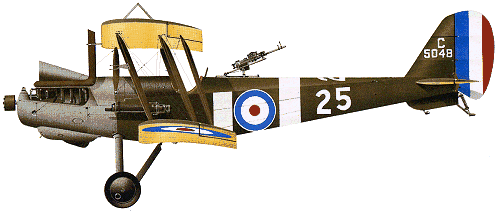 | ||
Manufacturers Standard Motor Company, Royal Aircraft Establishment | ||
The Royal Aircraft Factory R.E.8 was a British two-seat biplane reconnaissance and bomber aircraft of the First World War designed at the Royal Aircraft Factory. Intended as a replacement for the vulnerable B.E.2, the R.E.8 was widely regarded as more difficult to fly and gained a reputation in the Royal Flying Corps for being "unsafe" that was never entirely dispelled. Although eventually it gave reasonably satisfactory service, it was never an outstanding combat aircraft. In spite of this, the R.E.8 served as the standard British reconnaissance and artillery observation aircraft from mid-1917 to the end of the war, serving alongside the rather more popular Armstrong Whitworth F.K.8.
Contents
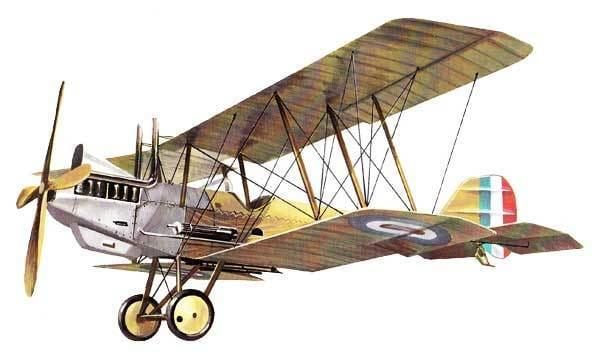
Over 4,000 R.E.8s were eventually produced and they served in most theatres including Italy, Russia, Palestine and Mesopotamia, as well as the Western Front.
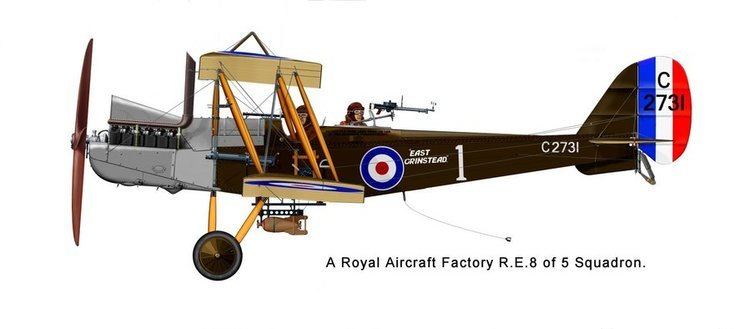
Design and development
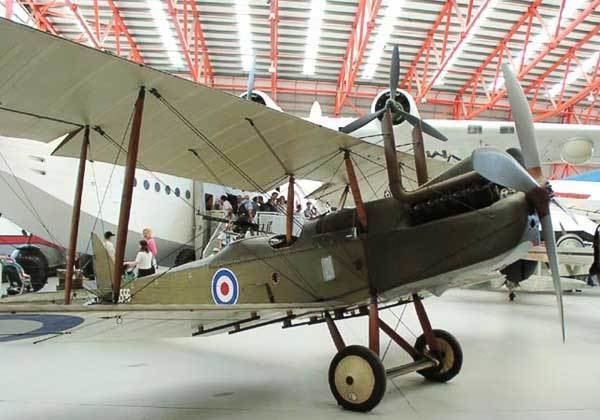
The first of two prototype R.E.8s (Reconnaissance Experimental 8) flew on 17 June 1916. Design of the new type had begun in late 1915, so that it was conceptually at least almost contemporary with the B.E.12 and the B.E.2e.

The installation of the 150 hp (112 kW) Royal Aircraft Factory 4a air-cooled V12 engine, closely resembled that of the B.E.12, with the same large air scoop and similar vertically mounted exhausts protruding over the upper wing to carry the fumes clear of the crew. The only real difference was that the engine was slightly raked back, to improve take off and landing characteristics.
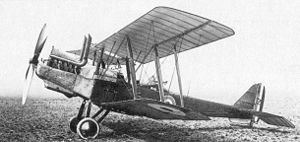
The single bay, unequal span wings were identical to those of the B.E.2e, although the span (and thus the wing area) was increased slightly by the use of a wider upper centre section, and lower stub wings to match. The tailplane was also the same as the B.E.2e. The entirely new parts of the design were confined to the fuselage aft of the engine firewall, and the vertical fin and rudder.
The new type was intended from the beginning to replace the B.E.2, which was already attracting widespread criticism, and an attempt was made to address each of the earlier type's failings. The more powerful motor was intended to improve the feeble speed and climb of the B.E.2 and to allow a better payload. This permitted the type to operate as a true two-seater, since the observer no longer had to be left at home when bombs or a full fuel load were carried, there was no need for his seat to be at the centre of gravity – as a result he could now be seated behind the pilot, in the proper position to operate a defensive machine gun. It was also possible to allow for a pilot's gun. The new wings had already proved themselves on the B.E.2e, maintaining the stability of the B.E.2c while providing rather better manoeuvrability, although the long extensions on the upper wing looked as if they might collapse if the aircraft was dived too sharply, which did not improve the trust in which they were held by some pilots. The new tail, as originally fitted, had a much smaller fin, which it was hoped would improve rudder control and allow the new type to turn more easily without seriously affecting stability.
In July, the second of two prototypes was sent to France for service trials, which were successful, aircrew being generally quite favourably impressed; and by September production was well under way. The Vickers-Challenger interrupter gear and the Scarff ring were still in short supply, being required for the Sopwith 1½ Strutter and other types, and a few early R.E.8s were built with a pillar mounting for the observer’s gun as an interim measure. An alternative to the pilot's synchronised Vickers had been designed, consisting of a fixed Lewis gun with deflector plates fitted to the propeller, although this was never used, a Vickers gun for the pilot being mounted on the port side of the fuselage in a similar position to that on the B.E.12, at first synchronised by the Vickers-Challenger gear and then by the improved Constantinesco hydraulic gear. Photographs of this armament installation make it clear that the cocking handle of the Vickers gun was in easy reach of the pilot and that a normal Aldis sight was mounted in the pilot's windscreen, giving the lie to statements that the forward firing gun could not be sighted properly due to its position.
To make the R.E.8 less tiring to fly, the pilot's controls included a wheel to adjust the tailplane incidence in flight and a form of primitive rudder trim (applied to the rudder bar) was provided to alleviate the constant pressure necessary to counteract the torque of the propeller. Basic flight controls were installed in the observer's cockpit and folded out of the way when not in use. They were connected to the elevators, rudder and throttle but not to the ailerons, and were intended to give observers a chance to make a forced landing if the pilot was killed or incapacitated rather than to offer true dual control.
Although less underpowered than the B.E.2, the R.E.8 was still handicapped by an inadequate powerplant and a model re-engined with the Hispano-Suiza engine was projected from quite an early stage as the R.E.8a. The cowling designed for the liquid-cooled engine closely resembled that of the B.E.12b and the S.E.5a. Supplies of Hispano-Suiza engines, more urgently required for other types, never permitted production of the R.E.8a, although a prototype was built and tested in December 1916. Plans to mount Rolls-Royce aero engines, such as the Eagle were also abortive, for similar reasons. These engines were in chronically short supply and reserved for other types such as the D.H.4 and the Bristol Fighter.
A total of 4,077 R.E.8s were produced with a further 353 on order cancelled at the end of the war. As well as the Royal Aircraft Factory, several private companies built R.E.8s, including Austin Motors, Daimler, Standard Motors, Siddeley-Deasy and the Coventry Ordnance Works.
Operational history
The first production aircraft reached 52 Squadron Royal Flying Corps (RFC) in France in November 1916. The inexperienced pilots of 52 Squadron found their new mounts thoroughly dangerous and several were killed spinning in off a stall while attempting to land; they were grateful to return to the B.E.2e by exchanging aircraft with 34 Squadron in January 1917. Experienced pilots had fewer problems with the new type and re-equipment of B.E.2 squadrons continued. Pilot's notes for the R.E.8, prepared in the field, drew attention to the fact that it had a higher landing speed than the B.E.2e (hardly surprising, since it was heavier and had almost the same wing area) and that it gave almost no warning of a stall. This seems to have been the source of most complaints about the type's "trickiness".
The Royal Aircraft Factory conducted spinning tests on the type, concluding that the R.E.8 was quite hard to spin and recovered easily; but the fin was redesigned with slightly increased area to improve spin recovery. The modification resulted in the production version being no less stable than the B.E.2e; and while this was an advantage for artillery observation and photography it gave the R.E.8 little chance to out-manoeuvre enemy fighters. A larger fin was fitted to some R.E.8s used as trainers. Some pilots flew the R.E.8 with an empty reserve fuel tank (or even filled the tank with fire extinguisher fluid) to avoid a perceived tendency of R.E.8s to burn on crashing. None of these measures would have made the aircraft any "safer", if the problem was one of poor stalling characteristics. Several pilots who flew the type mentioned that they had no problems but were careful to keep the airspeed well above stalling point.
R.E.8s began to arrive at the front in numbers just as the period of German air superiority known as "Bloody April" was taking a heavy toll of all types in the RFC; and early service was not auspicious. On 13 April 1917, six R.E.8s from 59 Squadron were sent on a long range photo reconnaissance mission, missed their intended escorts, and were met by the picked fighter pilots of Jasta 11, who shot them all down within five minutes.
The casualty rate in R.E.8 squadrons became more sustainable as new Allied fighter types regained air superiority and pilot training and tactics improved. Although never a popular aeroplane, it was reasonably satisfactory for the tasks demanded of it and was even regarded with some affection, gaining the rhyming slang nickname "Harry Tate" (after a popular music hall artist of the time). Some crews flew their slow, cumbersome mounts quite aggressively; the German fighter ace Eduard Ritter von Dostler was shot down by an R.E.8 of 7 Squadron, while 3 Squadron Australian Flying Corps (AFC) was credited with 50 air victories in 12 months of operations. Lts Pithey and Rhodes of 12 Squadron were the most successful R.E.8 crew in air-to-air combat, being credited with twelve victories.
Although supplemented by other types, the R.E.8 remained the standard RFC artillery observation, air photography and general short range reconnaissance aircraft for the remainder of the war, equipping 18 RFC squadrons in 1917 and 19 squadrons in 1918. Belgium was the only country other than Britain and the Dominions to operate the R.E.8 during the First World War, receiving 22 in July 1917. At least some of the Belgian examples were fitted with Hispano-Suiza engines, in a SPAD type cowling, rather than the S.E.5a type cowling of the R.E.8a.
It was hoped to be able to replace the R.E.8 with a version of the Bristol Fighter powered by the Sunbeam Arab engine but the combination proved unsuccessful and few "Arab Bristols" were ever built. A few R.E.8 squadrons were issued with one or two standard (Falcon engined) F.2bs in the last weeks of the war. By November 1918, the R.E.8 was regarded as totally obsolete and surviving examples were quickly retired after the Armistice with Germany. Nor was the type popular with the private owners who purchased surplus RAF aircraft after the war and no R.E.8s came onto the civil register.
Variants
Survivors
Only two "original" R.E.8s survive from World War One.
The restoration of R.E.8 F3556 at the Imperial War Museum Duxford was completed in 2004. This aircraft, built by Daimler, arrived in France on Armistice Day, still in its original packing case. It is currently displayed suspended from the roof of the AirSpace hangar at Duxford.
The other surviving R.E.8 is a former Aviation Militaire Belge machine preserved at the Brussels Air Museum. It is fitted with the usual Hispano-Suiza engine typical of R.E.8s in Belgian service, in the usual SPAD type cowling and circular frontal radiator .
The Royal Air Force Museum at Hendon has a full size replica RE.8, which was built by The Vintage Aviator Ltd ( TVAL ) in New Zealand in 2011. It is fitted with a "new build" RAF 4a engine and was successfully test flown at Masterton, NZ, on 1 January 2012, with the registration ZK-TVC. Crated and shipped to England, it was reassembled at The Shuttleworth Collection at Old Warden Airfield in June 2012 and undertook a number of flights painted as 'A3930' of No. 9 Squadron Royal Flying Corps, before being sent by road to Hendon in November 2012. It is now on static display in the Grahame-White Factory.
Operators
Specifications
Data from The Royal Aircraft Factory
General characteristics
Performance
Armament
